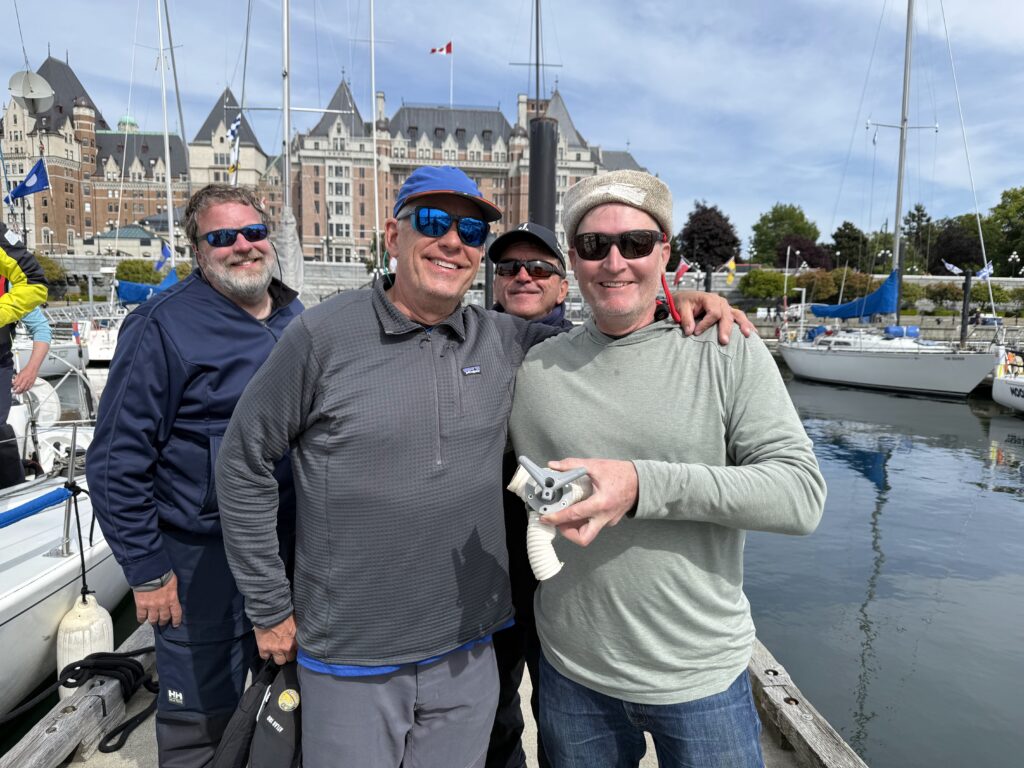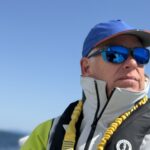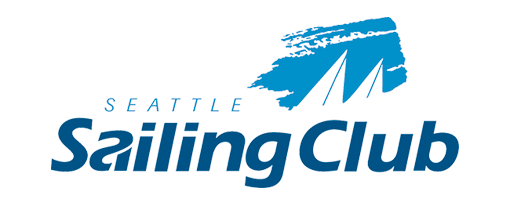A First to Remember: Swiftsure 2025 by Captain Mike L.
A First to Remember: Swiftsure 2025!
I’ve heard about the Swiftsure race for many years, all the drama that unfolds, the extreme
conditions of beating into the wind and waves, or the drifting in the doldrums that gave the
race the nickname “Driftsure” from time to time. We had both in 2025!
It has been said, “The nature of the course and the notoriously unpredictable winds and currents
provide an exacting test of seamanship.” While a little understated, this would sum it up well.
This was my first Swiftsure. I always wanted to do a Swiftsure, and Van Isle, and a Vic-Maui (or
Trans-Pac from California where I used to live and race.) Or at least as long as I knew about it
which was five years ago when I moved to the PNW. I pictured myself on a large 40-70’
monohull, charging through the wave either at the helm, or at least on the rail serving as
movable organic ballast.
So when I had the opportunity to race on a J/105 with seven people, I could not turn it down. I
was a little puzzled how a J/105 could fit seven sailors for a two-day race, but I was pleasantly
surprised that, while tight, there was plenty of room for seven and our provisions, and even our
gear.
This year the Seattle Sailing Club along with CYC had several familiar J/105’s in the race
including Moose Unknown, Panic, Jaded, Puff, Mazu, and Creative where I was one of the
coaches.
Preparation for this race resembles an offshore race. Swiftsure uses the Category 3 Offshore
Special Regulations (OSR) for Monohulls & Multihulls. In short this means that lot of effort is
required to prepare for the race including recording details of the crew and their emergency
contacts, and layers of safety equipment as well as boat capabilities, systems, and gear are
required. A large of amount of time that starts months, weeks, days, and hours before the race
is required to meet all of these regulations. This in itself was a huge part of the experience and
a learning experience for everyone involved; from staff, maintenance personnel, to members,
and captains.
Following the finish of the race, all boats can be inspected (and most finishing boat are
inspected) where the race organizers pick a random crew member to find three emergency
items on the boat unaided by any other crew members. If you a crewmember can’t find an
item, their finishing time can be penalized. Boats can also be inspected at any time before the
race.
The Delivery to Victoria – Thursday
We used the delivery up and down to teach an ASA 106 class for three of the crew; Sean, J.P.
(James Patrick), and Jason. Captain Gene was co-teaching and had a lot of illustrative examples
and experiences of cruising and captaining to share. We motored starting at ~5:30 am on
Thursday and arrived ~3 pm with virtually no waiting at Customs & Immigration. We motored
nearly the whole way on smooth waters fighting little to no currents.
The Canadians were so accommodating they had actual border control agents were on hand to
rapidly clear us and the boat into Canada versus waiting and taking turns on the yellow
telephones where you clear immigration and custom remotely from a distant voice somewhere
in Ontario.
Skipper’s Meeting at The Royal Victoria Yacht Club – Thursday
One of the fun components of the race was the skipper’s meeting at the sponsoring yacht club,
the Royal Victoria Yacht Club. This was a fun experience to see a yacht club that was founded in
1892, and added the prefix “Royal” when King George V recognized its growth and stature in
1911. 2024 Swiftsure trophies were passed out, and lots of Swiftsure celebrities and salty
sailors who race 40+ years of the 80 races run to date.
– A fun origins story of the yacht club is listed on RVYC website and explains:
“A yacht race held to celebrate Queen Victoria’s birthday was the catalyst that led to the
creation of the Victoria Yacht Club on June 8th, 1892. The first races, held in the 1880s,
were originally contested only by local sportsmen, but in 1892, four American boats
appeared and swept the board, winning the top four races. This outrage spurred the
local sportsmen into forming a yacht club.”
The Race – Saturday through Sunday
For the race we had Michael Sawyer as the official skipper and coach, and myself as another
coach. Crew included Pream, Nick, Sean, JP, & Jason.
As one of the many items to prepare for the race, we made sure we knew how to configure the
Marine Sanitation Device (MSD) to dump overboard, or go the tank using the Y-valve. We got
some help the night before the race, and in the morning of the race we realized that the Y-valve
was still actually frozen. We discovered while trying to turn the valve the day before we
cracked the stem of the valve and waste water from the MSD was now running out of the valve
body down the wall in the head. (?!) An MSD is a requirement for the race, so we had two choices. Run to the chandlery and fix it, or retire from the race. Without hesitation, the crew sprang into action with an hour and 40 minutes to the start. Captain Sawyer ran to his car and
headed to Home Depot (the chandlery didn’t open to after the start), and the rest of us went to
cutting, disassembling, and removing the Y-valve.

In the end, we ended up getting the line only 40 minutes late (you only have 90 minutes to start
the race after your official start), and we started the race surrounded by other boats. We felt
great for not having to abandoned the race before it started!
At the start the whole fleet was sailing against the current struggling to get around the
notorious Race Rock. With catching some back currents and eddies, we caught up to several
J/105s including Puff.
Later in the afternoon on Saturday, the wind picked up to a steady 25 kts and gusting a little bit
higher. After flattening the sail, and trying to dump as much wind as we could to recover a
better healing angle we decided to reef. At this point we realized, despite completing countless
items for the race, we did not have the reefing line pre-fed through the sail.
At this point I decided the only safe way I knew to run the reefing line in high wind and seas was
to put the boat into a run, stabilize the boat from pitching and heeling, bring the boom close to
the cockpit and run the line. This was successful, but it cost us several miles of double backing
and having to beat back into the wind.
That evening we finally made it to Neah Bay, about a half nautical mile from the round mark.
But we were way behind the fleet and the wind totally died on us. As the ebb current
continued to flow, we slowly got swept out to sea for the next six hours. At 7 am on Sunday
morning, and we were now ~2.5 nm from the Neah Bay mark and we ultimately made the hard
decision to retire from the race. The flood tide would start around 10:45 am, and hopefully the
wind would eventually pick up, but we would be even further behind on the 50 nm course back
to the finish. It’s not clear if we could have finished before the Sunday midnight cutoff or not.
It was a very frustrating decision.
– Captain Mike L., Race Coach & Sailing Instructor at Seattle Sailing Club



